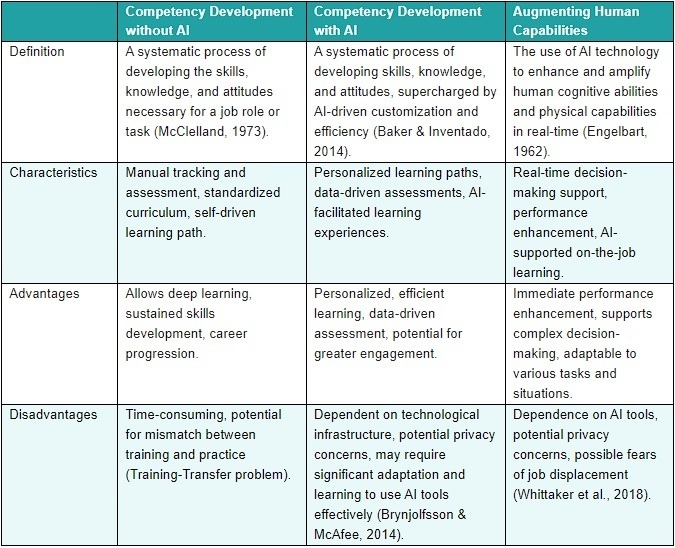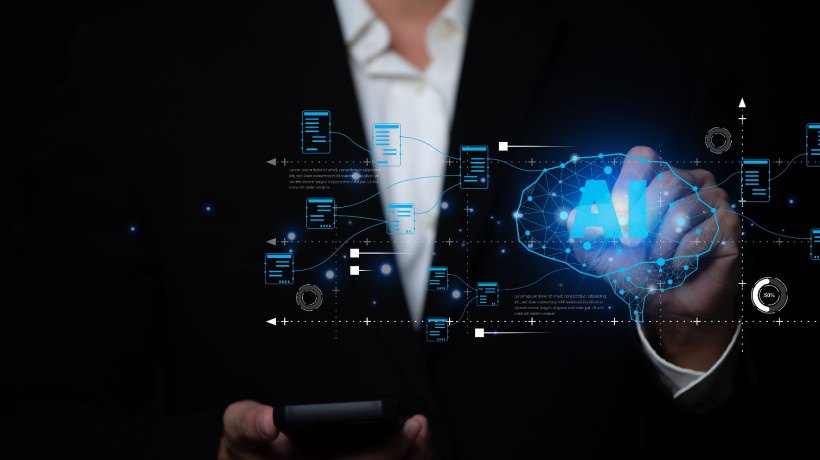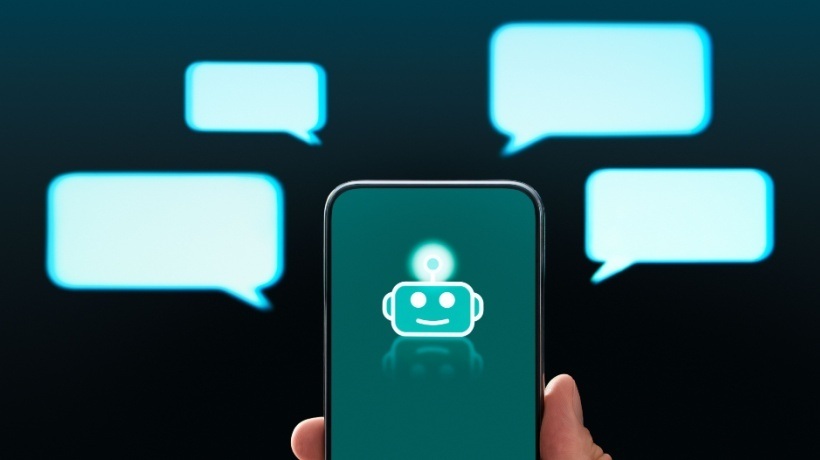L&D’s Role With And Without AI
Welcome back to our series (find part 1 here) exploring the transformative role of AI in Learning and Development (L&D). In this second part, we focus on a critical aspect of L&D—the dual objectives of competency development and the augmentation of human capabilities, in scenarios with and without the incorporation of AI. In our exploration, we delve into the synergy between competency development and capability augmentation—a synergy that, when harnessed effectively, can yield significant dividends. We also discuss how AI can catalyze this process, offering new possibilities for L&D professionals and departments worldwide. Join us as we uncover the intricacies of L&D's role in this era of AI and expanded human potential, drawing inspiration from Steve Jobs' metaphor shared in an iconic video, where he described computers as a "bicycle for our minds."
Competency Development Without AI
The concept of competency development dates back to the 1970s when David McClelland, a renowned psychologist, championed the idea of assessing individuals based on competencies rather than intelligence (McClelland, 1973). This concept has since served as a pillar in Learning and Development, focusing on enhancing individuals' skills, knowledge, and the attitudes necessary for their specific roles or tasks. The traditional model of competency development is often characterized by manual tracking and assessment, standardized curricula, and self-driven learning paths.
For instance, consider the case of "Global Tech Inc.", a multinational tech company. Before the advent of AI, their L&D department used to conduct extensive training programs to develop their employees' competencies. These programs were standardized, delivered through in-person sessions or online courses, and assessments were manually conducted by the trainers. While this method allowed deep learning and career progression, it often became time-consuming and hard to scale as the organization grew.
L&D’s Role
In traditional competency development, L&D professionals design and deliver evidence-informed structured learning programs to equip employees with the necessary skills, knowledge, and attitudes for their roles (Merriënboer and Kirschner, 2018; Neelen and Kirschner, 2020). This includes assessing learners' needs, developing curricula, providing instruction, and evaluating performance (Salas, Tannenbaum, Kraiger, and Smith-Jentsch, 2012). Despite the lack of AI, the human touch in the form of mentors, coaches, and trainers is critical in guiding learners and creating an engaging learning environment.
Competency Development With AI
Fast forward to today, and we see AI as a transformative force in competency development. The essence of AI's role in competency development lies in its ability to provide personalized learning experiences and data-driven assessments (Baker and Inventado, 2014). In this scenario, learning paths are tailored to the individual's needs and preferences, and progress is tracked automatically, making the learning process more efficient and potentially more engaging.
Take "Global Tech Inc." as an example again. After implementing an AI-driven L&D platform, they noticed a significant shift in how competencies were developed. The platform could analyze individual learning behaviors and recommend customized learning paths for each employee, making the learning experience more personalized and efficient. However, the shift also brought about new challenges, such as dependence on technological infrastructure and potential privacy concerns.
L&D’s Role
With the advent of AI, L&D's role is transforming, and one example is the introduction of AI-driven personal assistants for competency development. This new technology takes a leaf from the success of individual tutoring systems, such as Khan Academy's approach. Here, AI provides personalized learning experiences by understanding the learner's progress, strengths, and areas of improvement, and tailoring the content accordingly (Baker and Inventado, 2014).
For L&D professionals, this means a shift from traditional curriculum design to also curating and overseeing AI-driven learning experiences. They need to understand the capabilities and limitations of AI tools, select the most appropriate ones, and integrate them into the evidence-informed learning ecosystem. Furthermore, they must manage the change process, addressing employees' concerns about privacy or adapting to new learning methods, and ensuring a smooth transition to AI-enabled learning.
Augmenting Human Capabilities
While competency development focuses on enhancing skills and knowledge, augmenting human capabilities is about using AI to enhance and amplify human cognitive abilities and physical capabilities in real time (Engelbart, 1962). Here, AI doesn't just facilitate learning; it supports individuals as they perform tasks, making their work more effective and efficient.
Consider the case of "Logistic Solutions", a logistics company that implemented AI-powered robotics to augment their warehouse employees' capabilities. The AI system provided real-time guidance to the workers, helping them navigate the warehouse more efficiently, lift heavy items, and restock inventory accurately. This augmentation not only enhanced the workers' performance, but also helped them learn and adapt to new technologies while on-the-job.
L&D’s Role
Augmenting human capabilities goes a step further, as AI not only supports learning but also enhances human cognitive and physical abilities in real time (Engelbart, 1962). An example of this would be AI-powered performance support tools that provide on-the-job guidance, helping employees make complex decisions or master new tasks more quickly.
In this context, L&D professionals need to identify opportunities where AI can augment human capabilities, implement the right tools, and provide training for their use. This also involves creating a culture that embraces AI augmentation, reassuring employees that AI is a tool to enhance their capabilities, not replace them.
L&D Approaches: The Intersection Of Competency Development And AI Augmentation
As we journey through the transformative landscape of corporate learning, we come across different paradigms shaping how we perceive skills development. Let's summarize these approaches that offer distinct perspectives and potential for L&D—competency development without AI, competency development with AI, and augmenting human capabilities. See the table below:

Table 1: Summary of three L&D approaches with and without AI
Each of these three concepts—competency development without AI, competency development with AI, and augmenting human capabilities—presents a different approach to Learning and Development. While each has its unique benefits and potential challenges, they coexist and enrich the corporate learning landscape, leading us toward a future of more comprehensive, effective, and learner-centric education.
Across these three areas, L&D's role is not just about delivering training but also about enabling continuous learning and performance enhancement in an increasingly digital world. As we move forward, L&D will need to continue to evolve, leveraging AI to create more evidence-informed, personalized, efficient, and impactful learning experiences.
Up Next: Unpacking L&D's Role In The AI Era
As we close this chapter on the dual roles of L&D in competency development and human capability augmentation, we must ask ourselves: what is next on the horizon for L&D? How will these roles evolve as we delve deeper into the era of AI?
Well, you don't have to wait too long for the answers. In the next article, we will explore an even more exciting topic: how AI can act as a catalyst to supercharge the L&D process, giving rise to a new era of evidence-informed learning experience design. Stay tuned!
As you continue exploring the fascinating world of AI and its potential to revolutionize Learning and Development, we invite you to delve deeper with us. Visit our website Partners in AI for more in-depth information, insights, and the opportunities that AI brings to the corporate learning sphere.
This article series titled "Is AI the Bicycle of the Mind?" serves as a prelude to my upcoming book, Value-Based Learning, offering a sneak peek into the insightful content that the book will feature. Please note that all rights to the content in these articles and the upcoming book are reserved. Unauthorized use, reproduction, or distribution of this material without explicit permission is strictly prohibited. For more information and updates about the book, please visit: Value-Based Learning.
References:
- Baker, R. S., and P. S. Inventado. 2014. "Educational data mining and learning analytics." In Learning Analytics, edited by J. Larusson and B. White, 61-75. New York: Springer.
- Brynjolfsson, E., and A. McAfee. 2014. The Second Machine Age: Work, Progress, and Prosperity in a Time of Brilliant Technologies. New York: W. W. Norton & Company.
- Engelbart, D. C. 1962. "Augmenting Human Intellect: A Conceptual Framework." Summary Report, AFOSR-3233.
- Hagel, J. 2017. "Technology’s Role in Managing Knowledge Flows." Deloitte Insights.
- McClelland, D. C. 1973. "Testing for competence rather than for intelligence." American Psychologist, 28 (1): 1-14.
- Merriënboer, J., and P. Kirschner. 2018. Ten Steps to Complex Learning. A Systematic Approach to Four-Component Instructional Design. New York and London: Routledge.
- Neelen, M., and P. A. Kirschner. 2020. Evidence-Informed Learning Design: Creating Training to Improve Performance. London: Kogan Page Publishers
- Russell, S., and P. Norvig. 2016. Artificial intelligence: a modern approach. Kuala Lumpur: Pearson Education Limited.
- Salas, E., S. I. Tannenbaum, K. Kraiger, and K. A. Smith-Jentsch. 2012. "The science of training and development in organizations: What matters in practice." Psychological Science in the Public Interest, 13 (2): 74-101.
- Whittaker, M., K. Crawford, R. Dobbe, G. Fried, E. Kaziunas, V. Mathur, and O. Schwartz. 2018. "AI Now Report 2018." AI Now Institute.
Image Credits:
- The table within the body of the article was created/supplied by the author.








